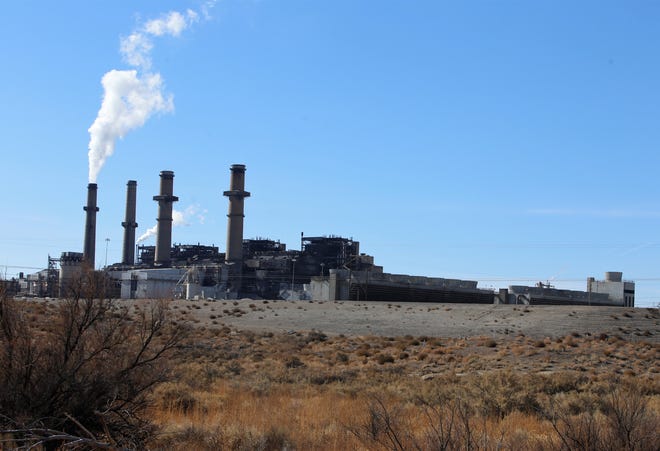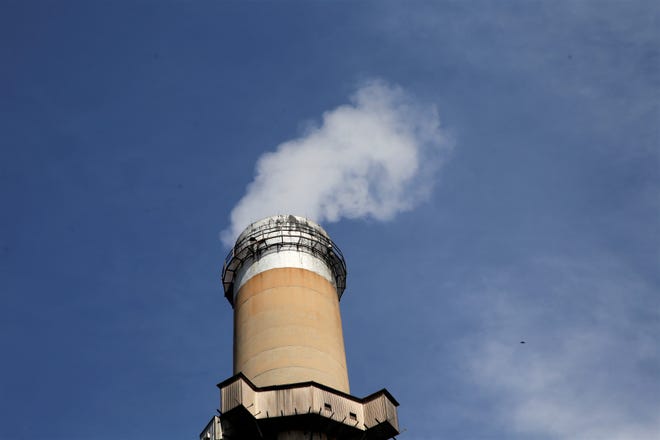What to know about the upcoming hearings regarding the San Juan Generating Station
Tentative schedule has witnesses lined up for cross examination Dec. 10 through Dec. 19
- A live audio stream of the hearings will be available online most of the days.
- Public comment will only be accepted on Dec. 9.
- State Sen. Steve Neville, R-Farmington, and FEUS director Hank Adair are among the 33 witnesses.
FARMINGTON — As debate continues about the future of the San Juan Generating Station, the New Mexico Public Regulation Commission has scheduled more than a week of hearings regarding Public Service Company of New Mexico’s application to stop operations at the San Juan Generating Station and refinance past investments into the plant.
This will begin with a public comment hearing at 9:30 a.m. Dec. 9 in Apodaca Hall on the second floor of the Old PERA building located at 1120 Paseo de Peralta in Santa Fe. Comments will be limited to three minutes per person.
More:PNM employees are preparing for the closure of San Juan Generating Station
The public comment hearing will be followed by an evidentiary hearing starting 9 a.m. Dec. 10 and continuing through Dec. 19. A live audio stream will be available online during the evidentiary hearing, except for on Dec. 11 and Dec. 18. The live stream will not be available on Dec. 11 and Dec. 18 because the PRC will have its weekly open meetings at the same time those days.
There will not be a PRC ruling on the case during the hearing. Instead, the hearing examiners will use it to develop a recommendation for the commission. The commission will discuss the case and the recommendation at a future date and will then issue an order.
This hearing is only for the abandonment and financing portion of PNM’s application. Replacement resources will be discussed during a hearing in January.
More:PNM proposes plan to move toward renewable energy sources, close SJGS
Here’s a brief look at five topics that will likely come up during the hearing.
Does the Energy Transition Act apply?

One of the central issues of the debate is whether the Energy Transition Act applies to the case, since the PRC had already opened a docket prior to the new law being passed. The various parties in the case will have to argue based on two scenarios — one where the law is applied and another where it is not applied.
The Energy Transition Act paved the way for PNM to refinance its past investments into the power plant using low-interest bonds. Instead of paying 7.2% interest on its debt, it will pay an estimated 3.38% interest. These bonds will be paid by ratepayers through a non-bypassable charge on their bills. It also creates economic assistance funds for impacted workers, the community and Navajo Nation.
More:Does NM's new energy law apply to San Juan Generating Station? That depends on who you ask
Should ratepayers help pay for miners' severance and job training?

The New Mexico Office of the Attorney General filed testimony by Andrea Crane, the president of a financial consulting firm called The Columbia Group, on Oct. 18. In her testimony, Crane argued that the Energy Transition Act should be applied, and PNM should be allowed to use securitization to refinance its past investments into the San Juan Generating Station. However, she disagreed with the amount PNM has asked for. Crane highlights that PNM has asked for $10.5 million of securitization funding for purposes not mandated by the Energy Transition Act. She said these costs should not be recovered from ratepayers.
PNM has asked to use $20 million for job training and severance for both the power plant and mine workers. Crane argues that only $14.6 million should be used for job training and severance. She opposed PNM’s proposal to pay mine workers job training and severance. Westmoreland’s job training and severance package is smaller than what PNM offers power plant workers. PNM has proposed paying $3.7 million to bring the job training and severance options for miners in line with what power plant workers will receive.
How should the costs be balanced between shareholders and customers?

When PNM closed units two and three at San Juan Generating Station, the shareholders and ratepayers shared the cost evenly. This was $257 million of undepreciated value in those two units. If the PRC grants securitization, PNM ratepayers will pay 100% of the debt. In exchange, shareholders will forego future profits
The PRC utility division staff have argued that shareholders should bear about half of the costs. They have proposed that ratepayers pay $141.5 million for past investments into the plant and another $28.6 million for decommissioning and reclamation for a total of $170.1 million.
Should PNM continue operations and retrofit with carbon capture?

One member of the PRC staff, Dhiraj Solomon, has recommended denial of the application because PNM did not evaluate carbon capture. PNM has since released a scenario where the utility continues to operate the plant with carbon capture. PNM officials say it would cost more to keep the power plant open with carbon capture technology than it would cost to close it and replace it with natural gas and renewables.
More:PNM: Carbon capture at San Juan Generating Station won't provide reliable, affordable electricity
What are the environmental impacts?

New Energy Economy will seek to prove the San Juan Generating Station has negligently caused lasting environmental and human health impacts. The advocacy group has submitted testimony by former mine and power plant workers about spills and incidents that occurred in the 1970s and 1980s in and around the sites. This will play into the group's argument that ratepayers should not be responsible for 100% of the costs to close the power plant.
Tentative schedule
The hearing examiners released a tentative schedule of witnesses on Nov. 26.
Dec. 10: PNM Vice President of Public Policy Ron Darnell and Vice President of Generation Thomas Fallgren will answer questions during a lengthy cross-examination.
Dec. 11: The second day will feature cross examination of three PNM witnesses — the utility’s director of resource planning Nicholas Phillips, a former Wisconsin utility regulator who also served in the U.S. Department of Energy Lauren Azar and Frank Graves, the principal at the economic consulting firm The Brattle Group.
Dec. 12: Day three of the evidentiary hearing will include discussion of the environmental impacts, starting with cross examination of PNM’s witness Douglas Cowin, the manager of the environmental remediation department at Burns & McDonnell, a consulting firm that has helped with remediation work at the power plant. PNM’s environmental services department manager John Hale will also appear for cross examination. Other witnesses may address the Energy Transition Act. PNM controller Henry Monroy and lead pricing analyst Michael Settlage will also appear for cross examination.

Dec. 13: The remaining three PNM witnesses will appear for cross examination. This includes PNM Resources Vice President of Human Resources Elisabeth Eden, PNM Executive Director of Regulatory Policy and Case Management Mark Fenton and Charles Atkins, a senior adviser at Guggenheim Securities, an investment banking and capital markets firm.
Dec. 16: After four days of cross examination of PNM witnesses, the evidentiary hearing will turn to New Energy Economy’s five witnesses starting with Steve Fetter, the president of a utility advisory firm based in Washington called Regulation UnFettered. Mark Hutson, a hydrogeologist who visited the power plant and mine in late October, will also appear for cross examination, as will ecological economist Charlotte Grubb. Former power plant chemist Norman Norvelle and former San Juan Mine worker Sterling Grogan will also appear. Grogan worked as head of the environmental division at the mine under Utah International in the 1970s and as environmental manager for BHP at the mine from 1984 until 1988.

Dec. 17: Andrea Crane, a witness for the attorney general’s office, is the first witness on the list for the sixth day. Western Resource Advocates’ witness Douglas Howe, the director of Western Grid Group, will also appear. Three Sierra Club witnesses as well as state Sen. Steve Neville, R-Farmington, and economist Kelly O’Donnell are also scheduled for cross examination. The Sierra Club witnesses include Senior Strategic and Technical Advisor Jeremy Fisher, independent consultant David Posner, energy engineer and consultant David Schlissel.
Dec. 18: Former nurse Adella Begaye will appear for cross examination. Begaye was a founding member of Diné CARE. The legal director of the Institute for Policy Integrity at New York University School of Law Jason Schwartz will also answer questions. Two PRC staff witnesses — Dhiraj Solomon and Anthony Sisneros — will also appear.

Dec. 19: The final day of the evidentiary hearing will include cross examination of two New Mexico Affordable Reliable Energy Alliance witnesses — James Dauphinais and Michael Gorman. Both witnesses are consultants from the firm Brubaker & Associates, Inc. In addition, PRC staff witnesses Beverly Eschberger and Marc Tupler will appear. Farmington Electric Utility System Director Hank Adair will also answer questions about the city’s plans to take ownership of the power plant and transfer the majority ownership to Enchant Energy.
Hannah Grover covers government for The Daily Times. She can be reached at 505-564-4652 or via email at hgrover@daily-times.com.
Support local journalism with a digital subscription: http://bit.ly/2I6TU0e